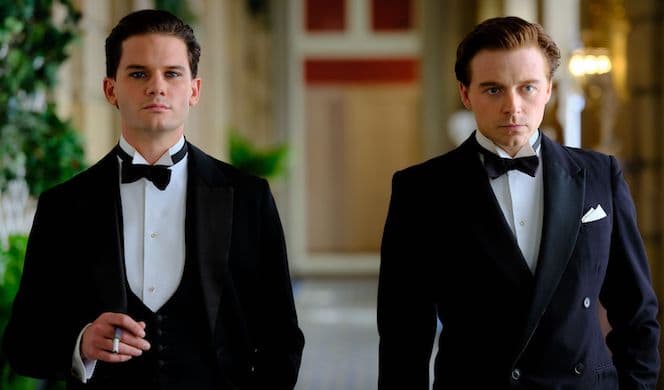The Wounds of World War I, Revisited With Grace and Melody
With ‘Benediction,’ all of director Terence Davies’s methods of storytelling and stylistic techniques are brought to bear on telling the story of Siegfried Sassoon.

The films of British director Terence Davies are generally gentle, contemplative works, quite like prayers. It’s only fitting that his latest is called “Benediction,” as it’s another in a line of the visually elegant, fastidiously written, quietly impactful movies he’s created since his first feature film, 1988’s “Distant Voices, Still Lives.” This is not to say that the occasional ruckus or shocking moments have no part to play. For all their stillness, his movies make room for the disorder of life: loud disagreements, jarring events, and the mental chaos of doubt, resentment, and regret.
With “Benediction,” all of Mr. Davies’s methods of storytelling and stylistic techniques are brought to bear in relaying the story of Siegfried Sassoon, the famed English poet and World War I veteran. The movie’s first 15 minutes alone employ archival footage, subtle special effects, and more to take the viewer from the relative peace of just before the war to the war itself and onto Sassoon’s reprieve from the battlegrounds due to “trench fever.”
It all culminates in a haunting sequence where Mr. Davies overlays the cowboy song “Riders in the Sky” above black-and-white stock imagery of cattle interposed with real battlefield clips. With the final strains of the song lingering, this segment then segues to the young Sassoon (Jack Lowden) sitting in a pew within a Catholic cathedral, and finally transforms the uniformed man into an aged individual in plains-clothes (the elderly Sassoon played by Peter Capaldi). One of the most audacious sequences in Mr. Davies’s career, it’s completely mesmerizing.
Sassoon’s popular poems detail the horrors of the war, and verses from these works are heard throughout the film via voiceover narration. Sassoon is also famous for a letter he wrote to his commanding officers explaining his objections to the war and how he felt it had turned from its aim of “defense and liberation” to an act of “aggression and conquest.” Narrowly avoiding a court martial, Sassoon was instead sent to a psychiatric hospital in Scotland with a diagnosis of “shell shock.”
The scenes during this convalescent period may put one in mind of Pat Barker’s moving novel “Regeneration,” but the film also includes the doctor overseeing Sassoon’s treatment sussing out the poet’s latent homosexuality, and even admitting to being gay himself. From this point on, the movie focuses on Sassoon’s affairs with various men, including fellow poet Wilfred Owen, whom he meets at the hospital, and Ivor Novello, the fashionable singer and songsmith he meets seemingly after the war.
The timeline is never entirely clear in Mr. Davies’s film. It’s implied that Sassoon returns to the front at one point (this is true to the historical record), but it’s presented so vaguely, so poetically, that the viewer is not sure. This is an example of both the movie’s potent spell and its frustrations, for its episodic structure soon leads to a lumpy middle section where various members of the “Bright Young Things” set come and go in Sassoon’s life of the 1920s. Exceedingly arch dialogue pervades this part, with jokes referring to Tunbridge Wells and the dual meaning of “gay” landing with a nearly audible thud of obviousness.
If melodrama is narrowly avoided, it can be attributed to the actors’ dry effectiveness and to Mr. Davies returning regularly to Sassoon’s memories of the war through poetic recitation and war footage. Mr. Lowden’s portrayal of Sassoon, both wide-eyed and skeptical, slowly becomes a harrowing embodiment of Post-Traumatic Stress Disorder, though this condition wasn’t understood as such until the 1970s.
How else to explain why Sassoon takes up with several lovers who are clearly not right for him, including a woman whom he later marries despite his homosexual proclivities? The safety of normalcy and complacency was too tempting a prospect for a man who had lived through what he called in a 1918 poem “the hell where youth and laughter go.”
In its final section, the movie descends into a depressing portrait of Sassoon as a bitter old man, one who barely speaks with his wife and argues often with his son. Thankfully, Mr. Davies continues to leverage music as commentary on and counterpoint to the action and settings. Music plays an integral role in all his movies, with whole sequences given over to montages and stately long shots suffused with melodic melancholy. As with Scorsese, Kurosawa, and other great directors, Mr. Davies knows how a well-chosen song or classical piece can elevate a good or great scene to the sublime.
“Benediction” ends by going back to the young Sassoon sitting on a park bench as he envisions the legless soldier depicted in Owen’s poem “Disabled.” Mr. Lowden’s voice intones the sad musings of the wheelchair-bound soldier, and the delicate orchestral beginning of Ralph Vaughn Williams’s “Fantasia on a Theme by Thomas Tallis” can also be heard. As the poem ends, the music’s stirring main motif floats in and Mr. Lowden’s face, by turns filled with pain, tears, and anger, is a thing to behold before the movie fades to black.

